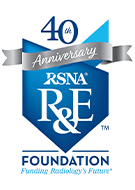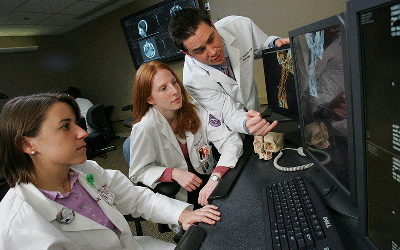Innovative Tool Helps Prepare Trainees to Take Call
Online resource, funded by an R&E Foundation grant, provides a standardized curriculum for trainees learning to take diagnostic radiology call


Taking call can be daunting for any resident or new attending after fellowship. These days, it may be more challenging than ever, given increasing study volumes and the wide variety of pathologies a radiologist may encounter.
Thanks to the efforts of Masis Isikbay, MD, and colleagues, trainees can now access a standardized, online tool to help guide them as they begin taking diagnostic radiology call.
“There is much variability in call practices among institutions, with a combination of interpretive and noninterpretive skills being required, such as protocolling, triaging, conversing with other providers and more,” said Dr. Isikbay, an assistant professor of radiology in the divisions of Emergency Radiology and Neuroradiology at the University of California, San Francsico (UCSF). “I felt it was important to create a centralized, web-based resource that would highlight some of the most important teaching points to help residents feel confident that they were able to perform at the appropriate level and keep patients safe.”
Dr. Isikbay, who received an RSNA R&E Foundation Educational Project Grant to create the resource, is now expanding the effort with support from an RSNA R&E Foundation Derek Harwood-Nash International Education Scholar Grant.
“Our work is focused on the diagnostic interpretative skills required for call preparation that we believe are universally beneficial to trainees practicing in all care settings. While it will take time to build up our online resources, we began with some of the ultimate do-not-miss diagnoses such as basilar artery thrombus and closed loop small bowel obstruction,” he said.

Designing The Curriculum to Be Accessible
The mobile-friendly platform uses an online picture archiving and communication system (PACS) server that can be accessed by users in the U.S. and abroad.
“Digital Imaging and Communications in Medicine (DICOM) images from important teaching cases—such as basilar thrombus—were downloaded and anonymized at our home institution,” he said. “These cases were organized into teaching albums on the PACS server we created, and were organized by specialty, disease topic, anatomic considerations and modality.”
Dr. Isikbay then created educational figures that highlight key teaching points for each topic as well as tutorial videos that demonstrate search patterns for the uploaded cases. These were put into YouTube video playlists organized by specific teaching topics that correspond to the teaching albums.
“Using the established education website stepwards.com, all the content was integrated into webpages that are organized by topics corresponding to the PACS albums and YouTube video channels,” Dr. Isikbay said. “Each webpage includes text, figures, teaching videos and a link to the PACS server that allows users to review educational content in multiple forms and scroll through the same teaching cases highlighted in the educational videos.” Dr. Isikbay first created Stepwards while in medical school at Harvard as a platform for sharing notes and educational content with others, and he continues to maintain the website, stepwards.com.
According to Dr. Isikbay, the tool aims to centralize information about dangerous diagnoses that one might miss. He also designed it to include text, figures, tutorial videos and a full PACS setup to enable users to scroll through cases in the videos to mimic using a real-life interface.
“I also felt very strongly that there should be no financial barriers to the content—meaning no ads and no need for an account or subscription—and that international users should be able to access the resources,” he said.
Dr. Isikbay and colleagues have collected preliminary data on the tool’s efficacy by having users complete standardized call preparation quizzes. He is currently analyzing statistics gathered this past academic year, and recently met with mentees who will assist in creating more call preparation quizzes.
“These quizzes will be specific to each resident level so we can see how trainees progress throughout each year of education and how these resources help them,” Dr. Isikbay said.
Gaining Users, at Home and Abroad
According to Dr. Isikbay, developing and refining this curriculum has become an international effort. Dr. Isikbay is working with physicians at institutions across the U.S. as well as in Armenia, Greece, Nairobi, Nigeria, and the Gambia.
As of June 2024, stepwards.com has approximately 10,000 U.S. monthly users and 8,000 monthly international users in countries such as India, the United Kingdom, Australia, South Korea, Thailand and other international locales. Additionally, the corresponding Stepwards YouTube channel has amassed over 1 million views (including videos created for this call preparation curriculum). At a recent symposium, Dr. Isikbay introduced the curriculum to U.S. and international trainees and invited them to provide feedback.
“I have used this platform as a way to connect with residency programs around the world, and I frequently give specific call preparation lectures to programs that are interested,” he said, noting that he looks forward to connecting with more programs in the future.
“Because of the RSNA grant, I have support to purchase software for collaborators so that I can help institutions set up their own local teaching files that can connect with the online curriculum,” he said.
With funding from the Derek Harwood Nash Education Scholar Grant, Dr. Isikbay and colleagues will continue to add specific disease processes to the platform while expanding the network of those involved in developing and growing the platform across the globe.
“We view this as a sustainable effort that can be expanded upon for many years to come,” Dr. Isikbay said.
For More Information
Access the Radiology paper, “Challenges of Preparing for Diagnostic Radiology Call.”
Visit the Stepwards site.
Read previous RSNA News stories on education for trainees: